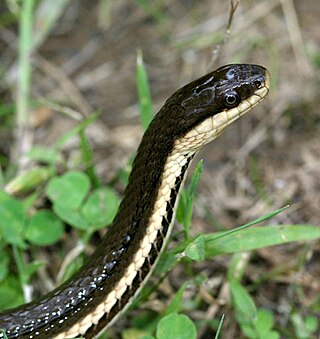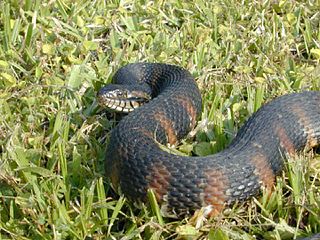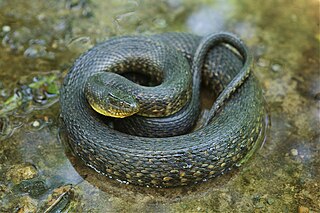
Agkistrodon piscivorus is a species of venomous snake, a pit viper in the subfamily Crotalinae of the family Viperidae. It is one of the world's few semiaquatic vipers, and is native to the Southeastern United States. As an adult, it is large and capable of delivering a painful and potentially fatal bite. When threatened, it may respond by coiling its body and displaying its fangs. Individuals may bite when feeling threatened or being handled in any way. It tends to be found in or near water, particularly in slow-moving and shallow lakes, streams, and marshes. It is a capable swimmer, and like several species of snakes, is known to occasionally enter bays and estuaries and swim between barrier islands and the mainland.

The queen snake is a species of nonvenomous semiaquatic snake, a member of the subfamily Natricinae of the family Colubridae. The species is endemic to North America.

Nerodia is a genus of nonvenomous colubrid snakes commonly referred to as water snakes due to their aquatic behavior. The genus includes nine species, all native to North America. Five of the species have recognized subspecies.

Nerodia rhombifer, commonly known as the diamondback water snake, is a species of nonvenomous natricine colubrid endemic to the central United States and northern Mexico. There are three recognized subspecies of N. rhombifer, including the nominotypical subspecies.

The Florida cottonmouth is a species of venomous snake, a pit viper in the subfamily Crotalinae of the family Viperidae. The species is endemic to the United States, where it occurs in southern Georgia and the Florida peninsula in nearly every type of wetlands in the region, including brackish water and offshore islands. However, it is not entirely dependent on water and is occasionally encountered as far as a mile from surface water. Agkistrodon conanti venom is very hemolytic and known to cause relatively extensive necrosis compared to many snake venoms, and can sometimes be lethal with a 17% mortality rate. It is often confused with harmless watersnakes (Nerodia) and other semi-aquatic species with which it shares its habitat.
Nerodia paucimaculata, commonly known as the Concho water snake, is a species of mostly aquatic, nonvenomous snake in the family Colubridae. The species is endemic to Texas in the United States.

The banded water snake or southern water snake is a species of mostly aquatic, nonvenomous, colubrid snakes most commonly found in the Midwest, Southeastern United States.

Nerodia clarkii, commonly known as the salt marsh snake, is a species of semi-aquatic, nonvenomous, colubrid snake found in the southeastern United States. Their range extends along the brackish salt marshes of the Gulf of Mexico and the Atlantic Coast from Texas to Florida, with an additional population in northern Cuba. Different subspecies of this snake are primarily identified via color patterns on each snake's belly, or anterior.

The copperbelly water snake or copperbelly is a subspecies of nonvenomous colubrid snake endemic to the Central United States.

The Florida banded water snake, a subspecies of the banded water snake, is a nonvenomous natricine colubrid native to the southeastern United States.

Lampropeltis getula, commonly known as the eastern kingsnake, common kingsnake, or chain kingsnake, is a harmless colubrid species endemic to the United States. It has long been a favorite among collectors. Four subspecies are currently recognized, including the nominate subspecies described here. All of these taxa had originally been described as distinct species and recognized as such for up to 101 years.

The green water snake is a common species of nonvenomous natricine snake endemic to the southeastern United States.

The brown water snake is a large species of nonvenomous natricine snake endemic to the southeastern United States. This snake is often one of the most abundant species of snakes found in rivers and streams of the southeastern United States, yet many aspects of its natural history is poorly known. Due to abundance and distribution throughout its biological range, this species could be used to investigate anthropogenic impacts on aquatic ecosystems by studying their movements.

The midland water snake, a subspecies of the northern water snake, is a nonvenomous natricine snake, which is endemic to North America.

Nerodia floridana, commonly known as the Florida green watersnake, or eastern green watersnake, is a harmless species of snake in the subfamily Natricinae of the family Colubridae. The species is native to the southeastern United States.

The common watersnake is a species of large, nonvenomous, common snake in the family Colubridae. The species is native to North America. It is frequently mistaken for the venomous cottonmouth.

The Lake Erie watersnake, a subspecies of the common watersnake, is a nonvenomous natricine snake. It is found on the offshore islands of Western Lake Erie, as well as the mainland of Ottawa County, Ohio. In 1999 the U.S. Fish and Wildlife Service listed the subspecies as a threatened subspecies after the population fell to 1,500 individuals. In 2011, the subspecies was removed from the list after the population increased to nearly 12,000 individuals by 2009.

















